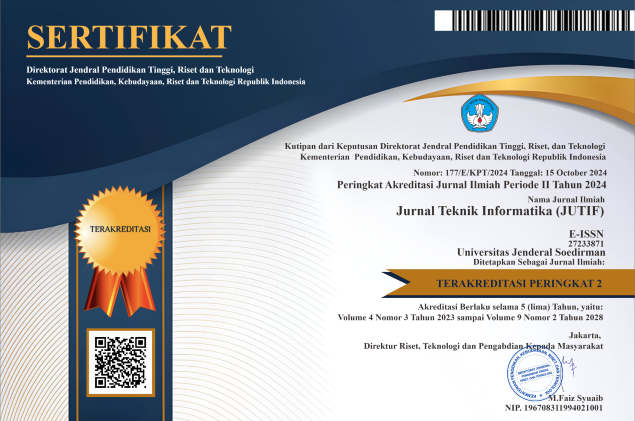A User-Driven E-Audit System for Improving Transparency and Efficiency in Regional Government Supervision
DOI:
https://doi.org/10.52436/1.jutif.2025.6.4.5145Keywords:
Audit Digital, Audit Trail, E-Government, E-Audit System, Inspectorate, Internal Control, User AcceptanceAbstract
Internal audit processes in regional government institutions often face challenges such as time inefficiency, low transparency, and poorly digitized documentation. This study aims to develop an E-Audit system to enhance the effectiveness of internal supervision in a regional inspectorate environment. Employing a user-centered design approach and a structured system development methodology, this research involved key roles—auditors, technical controllers, and follow-up teams—throughout the design and testing stages. The developed system integrates three core phases of the audit process—planning, reporting, and follow-up—into a single, modular, and interactive digital platform. Implementation results indicate a significant improvement in audit efficiency, with a reduction of more than 50% in process duration compared to manual methods. The system also enhances documentation consistency through digital audit trails, role-based dashboards, and automatic reporting features. User acceptance testing revealed a high level of satisfaction, with users highlighting the system’s ease of use, increased accuracy, and alignment with daily audit tasks. Additionally, user feedback emphasized the need for integrated notification features and inter-unit communication tools, indicating readiness for more advanced digital transformation. Overall, this study provides practical value as a model for digital audit implementation at the regional government level while contributing to the advancement of Computer Science through the application of software engineering principles and information systems to support digital government oversight. The developed E-Audit model can serve as a reference for designing real-time collaborative public auditing systems relevant to the development of information systems engineering and computational governance.
Downloads
References
M. Alenezi, “Understanding Digital Government Transformation,” arXiv e-prints, vol. 2202.01797, no. Januari, pp. 1–8, 2022, doi: https://doi.org/10.48550/arXiv.2202.01797.
J. Y. Stephen Goldsmith, “AI and the Transformation of Accountability and Discretion in Urban Governance,” arXiv e-prints, vol. 2502.13101, no. April, pp. 1–52, 2025, doi: https://doi.org/10.48550/arXiv.2502.13101.
P. Ciancarini, “Digital Transformation in the Public Administrations: a Guided Tour For Computer Scientists,” IEEE Access, vol. 12, no. May, pp. 22841–22865, 2023, doi: https://doi.org/10.48550/arXiv.2305.05551.
A. Wuttke, “Artificial Intelligence in Government : Why People Feel They Lose Control,” arXiv e-prints, no. May, pp. 1–39, 2025, doi: https://doi.org/10.48550/arXiv.2505.01085.
A. Wahyudi, “Digital Transformation in Public Service Management : Addressing Challenges in the Modern Era,” Sinomics, vol. 3, no. 4, pp. 1243–1252, 2024, doi: https://doi.org/10.54443/sj.v3i4.409.
D. Hicham, “Effects Of Digitalization On Internal Audit Activities And Practices : A Systematic Literature Review,” J. Namibian Stud., vol. 36, no. 2, pp. 174–190, 2023, doi: https://doi.org/10.59670/jns.v36i.4785.
O. Ilori, “Internal Audit Transformation in the Era of Digital Governance : A Roadmap for Public and Private Sector Synergy,” Int. J. Adv. Multidiscip. Res. Stud., vol. 4, no. 6, pp. 1887–1904, 2024, [Online]. Available: https://www.multiresearchjournal.com/arclist/list-2024.4.6/id-4161
B. Y. A. Hayrettin Usul, “Digital Transformation in Internal Audit: Paradigm Shifts, Emerging Risks, and Strategic Resilience,” EJDER, vol. 6, no. 1, pp. 23–36, 2025, doi: https://doi.org/10.5281/zenodo.15660150.
M. A. Sanni, J. J. Tinangon, H. Manossoh, M. Akuntansi, F. Ekonomi, and U. S. Ratulangi, “Peran Aparat Pengawasan Intern Pemerintah (Apip) dalam Pengendalian Fraud Pengadaan Barang/Jasa di Pemerintah Provinsi Sulawesi Utara,” Syntax Corp. Indones., vol. 8, no. 10, pp. 5595–5608, 2023, doi: https://doi.org/10.36418/syntax-literate.v8i10.13737.
J. Cao, “Study on the Effectiveness of Government Internal Audit,” Int. J. Educ. Humanit., vol. 4, no. 1, pp. 4–5, 2022, doi: https://doi.org/10.54097/ijeh.v4i1.1402.
D. Hidayat, “E-Government Integrated E-Audit System : Design And Analysis in The Internal Audit Unit of The Indonesian Government (APIP),” JASa (Jurnal Akuntansi, Audit dan Sist. Inf. Akuntansi), vol. 5, no. 1, pp. 37–52, 2021, doi: https://doi.org/10.36555/jasa.v5i1.1511.
M. Azizi, M. Hakimi, F. Amiri, and A. K. Shahidzay, “The Role of IT (Information Technology) Audit in Digital Transformation: Opportunities and Challenges,” Open Access Indones. J. Soc. Sci., vol. 7, no. 2, pp. 1473–1482, 2024, doi: https://doi.org/10.37275/oaijss.v7i2.230.
M. Daud, “Electronic Audit in Auditing Financial Statements of Local Governments,” Akunt. dan Sist. Inf. Electron., vol. 8, no. 1, pp. 112–117, 2023, doi: https://doi.org/10.32486/aksi.v8i1.412.
A. F. Kurniawan, “Peran Sistem Informasi dalam Meningkatkan Kualitas Audit Keuangan Pemerintah Daerah,” J. Econ. Bus., vol. 8, no. 1, pp. 936–948, 2024, doi: https://dx.doi.org/10.33087/ekonomis.v8i1.1822.
S. Mubiroh, “Analisis Implementasi E-audit untuk Pemeriksaan Keuangan Negara Studi pada BPK RI Perwakilan Daerah Istimewa Yogyakarta,” Berk. Akunt. dan Keuang. Indones., vol. 4, no. 1, p. 15, 2019, doi: https://doi.org/10.20473/baki.v4i1.11908.
N. Rizun and N. Edelmann, “Application of Text Analytics in Public Service Co-Creation: Literature Review and Research Framework,” arXiv e-prints, vol. 2305.18316, no. May, pp. 1–18, 2023, doi: https://doi.org/10.48550/arXiv.2305.18316.
N. A. M. A. Ramli, Nor Syafiqah Ahmad, “Integrating Technology in Government Internal Audit: Catalysts and Challenges,” Inf. Manag. Bus. Rev., vol. 16, no. 1, pp. 124–136, 2024, doi: https://doi.org/10.22610/imbr.v16i1(I).3668.
M. A. A. Pramuja Sigit Wahono, Safuan, “Penggunaan Aplikasi E- Audit Dalam Sistem Informasi Manajemen Inspektorat Polri,” J. Ilm. Glob. Educ., vol. 4, no. 2, pp. 1122–1130, 2023, doi: https://doi.org/10.55681/jige.v4i2.869.
B. Azizatun, “Challenges of Implementing an Electronic-Based Government System in Local Governments,” in ICoGPASS, KnE Social Sciences, 2022, pp. 117–127. doi: https://doi.org/10.18502/kss.v7i9.10932.
J. Jacob, P. Latupeirissa, N. Luh, Y. Dewi, I. K. R. Prayana, and M. B. Srikandi, “Transforming Public Service Delivery : A Comprehensive Review of Digitization Initiatives,” Sustainability, vol. 16, no. 7, 2024, doi: https://doi.org/10.3390/su16072818.
T. Volodina, G. Grossi, and T. Volodina, “Digital transformation in public sector auditing : between hope and fear,” Public Manag. Rev., vol. 27, no. 5, pp. 1444–1468, 2025, doi: https://doi.org/10.1080/14719037.2024.2402346.
A. I. Jiwandono and H. Sofyani, “Key Determinants Of Government Auditor’s Behaviour To Adopt Big Data Analytics In Audit Practice,” J. Akunt. Bisnis, vol. 17, no. 2, pp. 182–197, 2024, doi: https://dx.doi.org/10.30813/jab.v17i2.6000.
P. Purnamasari and R. Hartanto, “Effectiveness of E-Audit Implementation in the Indonesian Audit Board,” KnE Soc. Sci., vol. 7, no. 17, pp. 235–241, 2022, doi: https://doi.org/10.18502/kss.v0i0.12333.
J. Xin, K. Du, and Y. Xia, “The Impact of Enterprise Digital Transformation on Audit Fees — An Intermediary Role Based on Information Asymmetry,” Sustainability, vol. 16, no. 22, pp. 1–21, 2024, doi: https://doi.org/10.3390/su16229970.
A. Mujalli, “The influence of E-auditing adoption on internal audit department performance amid COVID-19 in Saudi Arabia The influence of E-auditing adoption on internal audit department,” Cogent Bus. Manag., vol. 11, no. 1, p., 2024, doi: https://doi.org/10.1080/23311975.2023.2295608.
A. Jaelani and J. Iskak, “International Journal of Current Science Research and Review Analyzing Audit Follow-Up Performance : Comparison Before and During SIPTL Application Implementation,” IJCSRR, vol. 07, no. 12, pp. 9176–9188, 2024, doi: https://doi.org/10.47191/ijcsrr/V7-i12-59.
A. I. Fanada, “Website-based implementation in information systems for supervisory management purposes,” JIPI (Jurnal Ilm. Penelit. dan Pembelajaran Inform., vol. 9, no. 3, pp. 1395–1407, 2024, doi: https://doi.org/10.29100/jipi.v9i3.5341.
J. Lou, “Research and Analysis of the Impact of Company Digitalization on Auditing,” Highlights Business, Econ. Manag., vol. 9, pp. 719–728, 2023, doi: https://doi.org/10.54097/hbem.v9i.9252.
A. Saputro, S. Riyadi, S. Mudjijah, and E. Muhdaliha, “Transformasi Digital dan Inovasi Model Bisnis: Strategi Meningkatkan Kinerja Operasional Berkelanjutan Berbasis Kapabilitas Dinamis,” IMEIJ, vol. 6, no. 4, pp. 5259–5272, 2025, doi: https://doi.org/10.54373/imeij.v6i4.3442.
Additional Files
Published
How to Cite
Issue
Section
License
Copyright (c) 2025 Nur Aminudin, Nurul Hidayat, Dwi Feriyanto, Hafsah Mukaromah, Dita Septasari, Ikna Awaliyani

This work is licensed under a Creative Commons Attribution 4.0 International License.



























